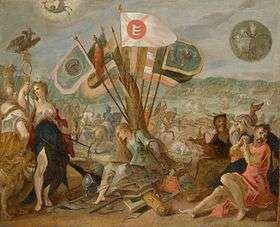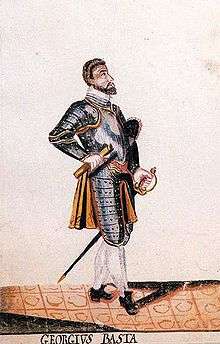Giorgio Basta
| Giorgio Basta | |
|---|---|
 | |
| Born |
1544 La Rocca, Kingdom of Naples |
| Died |
1607 (aged 62–63) Prague, Kingdom of Bohemia |
| Allegiance |
|
| Service/ | Imperial Army |
| Rank | General |
| Battles/wars | |
Giorgio Basta, Count of Huszt (1540 – 1607) was an Italian general, diplomat, and writer of Arbëreshë origin, employed by the Holy Roman Emperor Rudolf II to command Habsburg forces in the Long War of 1591–1606. He was later sent to administer Transylvania as an Imperial vassal[1] and to restore Catholicism as the dominant religion in the region.[2]
On his orders, his ally Michael the Brave, who ruled Transylvania, Wallachia, and Moldavia, was assassinated on 9 August 1601, a few days after the common victory at the Battle of Guruslău, for trying to turn against Rudolf II. For this, he is often depicted as disloyal and violent by Romanian and Hungarian historians. Basta was also the author of books on the art of military leadership.
Biography
Basta was born to an Arbëreshë family.[3][4][5][6][7][8] He is claimed to be born in La Rocca, modern day Roccaforzata, a village in Salento, Italy, however the bibliographic tradition claims he was born in Rocca sul Tanaro, Monferrato.
He was the son of Demetrio Basta, an Albanian Epirote who had fled the Ottoman conquest of the region to Italy, where he served the Spanish Empire. His father fought in the Piedmont countryside in the middle 1500s, and then in Flanders as commander of a cavalry regiment under the Duke of Alba. Very young, Basta became a soldier, and eventually got promoted to the rank of officer in a detachment commanded by Demetrio. Then after his father died, Basta served in a cavalry company run by his oldest brother Niccolò.[9][10]
He began his military career in Flanders, where the young officer impressed Don John of Austria, and gained the governorship of Nivelles.[11] Under the service of Charles V and Philip II of Spain, he commandeered mainly on the French front during the War of the Three Henrys and the Catholic League. In 1584, Basta gained his first major victory when his troops were blocking communications between Malines and Antwerp. Even in the Spanish defeat in Brussels in March 1585, the blockade of the city was achieved by Basta's troops. During the end of the year, the commissar general led the cavalry of the expeditionary body which at Charles de Mansfeld's orders rose to the moon. When the Catholics, in 1589, marched to retake Paris, it was the cavalry led by Basta who rescued the back of the Spanish army from the sudden attack of Henry of Navarre.
In 1590 he joined the forces of Alexander Farnese, Duke of Parma in Flanders. He returned to France in 1591, and partook in the siege of Rouen with the rank of Commander General of the cavalry. He however was almost killed by Sir Roger Williams, who sliced his neck in personal combat.[12] In February 1592 he separated Navarre from his greater army and the prince fled capture by his forces. He was tasked with ensuring communications between Rouen and the Netherlands, which was massively threatened by the French army, and then protecting the retreat of the Spaniards after the injury of Alexander Farnese to Caudebec. In 1596, after the death of the Duke of Parma, Balta followed the fate of many Italian princes, and had to abandon the Spanish. He then went to the service of Emperor Rudolf II, on the recommendation of Philip II, and served as general master in the army of Archbishop Mattia, later deputy governor of Upper Hungary, and finally the commander of the armies of Hungary and Transylvania. Ambrogio Merodio in his Istoria Tarantina, calls him the "terror of Ottoman arms".
For more than a decade, Basta fought against Hungarians, Transylvanians, Vlachs, and Tatars, gaining much fame of one of the best generals of the Empire. In 1597 he was released, together with General Schwarzenberg, from Pápa, which was conquered three years earlier by the Turks. In 1597, while he was deputy governor of Hungary, he recaptured the city of Huszt, which had rebelled against the Empire.
At the Battle of Mirăslău, Michael the Brave is defeated by Basta, forcing Michael to appeal to the Emperor Rudolf II to mediate the dispute with Basta.
On his orders, his ally Michael the Brave, the former ruler of Transylvania, Wallachia and Moldavia, was assassinated at Keresztesmező camp,[13][14][15] near Câmpia Turzii, because Basta considered him a liability. The event happened on 9 August 1601,[16] only days after a joint victory in Battle of Guruslău. He participated in the defense of Esztergom against the Turks (1605), and the continuous, tireless warfare against the Tatars' raids. During his brief period of control over Transylvania, Basta tried to uproot Protestantism. Following Papal and Imperial policy, Calvinist Hungarians and Székelys, Orthodox Wallachians and Serbs, and Lutheran Saxons were subject to any kind of abuse. Following years of warfare and his ruthless regime, famine and plague appeared in Transylvania. In 1604 Basta twice defeated forces led by Stephen Bocskai, who attempted to oppose his rule over Transylvania (see also: Bocskai Uprising).[17]
Following the murder of Michael and his defeat Báthory, Basta reached military commander of Transylvania, but his cruelty led to public discontent. Under his leadership, iniquities and murders are multiplied throughout Transylvania. At that time Rudolf II decided to recall him from command, leading to Basta's departure from Transylvania. After his experiences of warfare in Eastern Europe he went to Prague to live a quiet life; he died in the same city.
Basta wrote several military manuals, the best known of which are his Il maestro di campo generale...(Venice 1606), and his posthumous work Il governo della cavalleria leggiera (Venice 1612).[18] Both were translated into German and into French.
Contributions and Military Style
Basta was born into a period of transition from the tradition sword and shield to the gun. And cavalry switched from the Gendarme to lighter and armed cavalrymen, which valued quick cavalry charges. Due to influence from his father, he was a very strict observer of the rules, and the laws of a militia. When he worked for Alexander, Duke of Parma he was responsible for the renewal and restructuring of the cavalry weapon. However, during his early years, Basta experimented with his personal method of "mobile sculptures", which were small and numerous groups of cavalrymen who pushed in the forefront of the army, so as to create a complete "crown" in continuous movement; The method assured the army of sudden destructive capability and gave fruit in the French countryside.
The government of light cavalry is doubtless the most important work of Basta, as it represents the first organic regulation of light cavalry in Europe. Basta's theories led to the cavalry being releasing from its close ties with infantry, according to previous military tactics. To a degree, Basta's work is also largely anticipatory of further developments, especially in the concept of light cavalry being "the pupil of the armies" and in the reiterated need for a constant co-ordination of cavalry movements with those of other weapons : Theories, which influenced Raimondo Montecuccoli. Interesting remarks are made by Basta regarding the choice of cavalry officers to be performed not according to the nobility titles, but on a more meritocratic internship through the various degrees of the militia. He wants the captain to have absolute authority over all officers, "but always with the advice of the commissioner"; For the lieutenant requires a mature age, which can guarantee "credit and authority to the soldiers"; Young people must be the standard bearers, for the pursuit and adventurous spirit. Those carrying the banner must "have in their heads the guidance of all the others." Particular care is given by Basta on the question of the armament of the soldiers. The Blunderbuss should be equipped with an arbutus to carry with shoulder strap and a short sword, which allows to hit the tip, more timely and more effective, according to the dictation of the Italian school, rather than cutting. Among the Blunderbuss, who must be young and robust in shape, Basta estimates particularly Flemish to be best, not Italians, who prefer military in infantry.
The main quality of the lancers' wards must be, according to Basta, "velocity and collision velocity, i.e. velocity joint mass"; The gun armor is, besides the spear, a short sword for tip and picks that "can greatly benefit in retreat." On the "rules of residence", Basta illustrates the rules already dictated by Alessandro Farnese: the commissioner. It has to carry out topographic surveys and deal with all the logistical problems with the help of a "forier major", also providing the surveillance system for the equinox. Another important chapter is the one devoted to remote viewing, which Basta underlines as one of the main tasks of the cavalry. In this part, he sets out with great precision the various procedures to be followed to secure the large army of enemy surprises. Especially of personal experiences in the Netherlands and France, although he attributes the merit of introducing this use of cavalry to Duke of Alba. Finally, Basta deals with the tactical organization of light cavalry in combat, recommending the crescent moon, rather than the manipulative ones, in lines, in chessboard, in columns.
Gallery

 17th century aquarell of Basta
17th century aquarell of Basta.jpg) Street sign in Brindisi Montagna
Street sign in Brindisi Montagna
See also
References
- ↑ Jeremy Black (2002). European Warfare, 1494-1660. Psychology Press. pp. 199–. ISBN 978-0-415-27532-3.
- ↑ Setton, K.M. (1991). Venice, Austria, and the Turks in the Seventeenth Century. American Philosophical Society. ISBN 9780871691927.
- ↑ Hanlon, G. (2014). The Hero of Italy: Odoardo Farnese, Duke of Parma, His Soldiers, and His Subjects in the Thirty Years' War. OUP Oxford. ISBN 9780199687244.
- ↑ Coetzee, D.; Eysturlid, L.W. (2013). Philosophers of War: The Evolution of History's Greatest Military Thinkers [2 Volumes]: The Evolution of History's Greatest Military Thinkers. ABC-CLIO. ISBN 9780313070334.
- ↑ Murray, J.; BLEWITT, O.; PENTLAND, J.B. (1868). A Handbook for Travellers in Southern Italy ... Sixth edition [of the work originally written by Octavian Blewitt], revised and corrected on the spot. [The editor's preface signed: J. B. P., i.e. Joseph B. Pentland.].
- ↑ Hanlon, G.; Hanlon, U.R.P.G. (2008). The Twilight of a Military Tradition: Italian Aristocrats and European Conflicts, 1560-1800. Taylor & Francis. ISBN 9781135361433.
- ↑ Lawrence, D.R. (2009). The Complete Soldier: Military Books and Military Culture in Early Stuart England, 1603-1645. Brill. ISBN 9789004170797.
- ↑ Metamorphosis Transylvaniae. Taylor & Francis. 2014. ISBN 9781317856641.
- ↑ "BASTA, Giorgio in "Dizionario Biografico"". webcache.googleusercontent.com. Retrieved 2017-05-15.
- ↑ De Bartolomeis, Mario. "SAGGI LETTERARI E STORICI". xoomer.virgilio.it. Retrieved 2017-05-15.
- ↑ "BASTA, Giorgio in "Dizionario Biografico"". webcache.googleusercontent.com. Retrieved 2017-05-15.
- ↑ Lawrence, David, The Complete Soldier: Military Books and Military Culture in Early Stuart England, 1603-1645, Brill, 2009, p.66.
- ↑ István Kakas (1556–1603): Persiai utazás (Trip to Persia)
- ↑ Erdélyi Múzeum 1894/11
- ↑ adatbank.transindex.ro
- ↑ Giurescu, p. 201–05.
- ↑ Venice, Austria, and the Turks in the seventeenth century Volume 192 of Memoirs of the American Philosophical Society Author Kenneth Meyer Setton Publisher American Philosophical Society, 1991 ISBN 0-87169-192-2, ISBN 978-0-87169-192-7 Length 502 pages link
- ↑ "Giorgio Basta - Enciclopedia României - prima enciclopedie online despre România". enciclopediaromaniei.ro. Retrieved 2014-09-22.
External links
- Il mastro di campo generale (Venice, 1606) available on Google Books from Biblioteca Nazionale Centrale di Roma
- German translation: Il maestro di campo generale, das ist: außfürliche Anzeig, Bericht und Erklärung von dem Ampt eines General-Feldt-Obersten (Frankfurt, 1617) available on Google Books from Austrian National Library
- Il governo della cavalleria leggiera (Venice, 1612) available on Google Books from Complutense University of Madrid (scans in reverse order)
- German translation: Governo della cavalleria, Das ist, Bericht Von Anführung der leichten Pferde (Frankfurt, 1614) available on Google Books from Austrian National Library